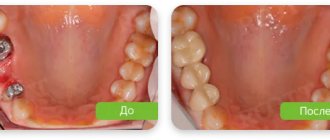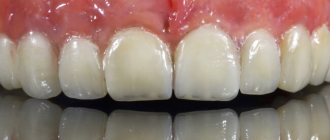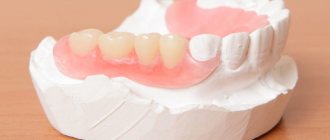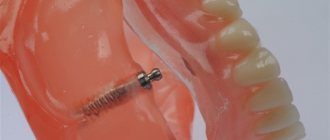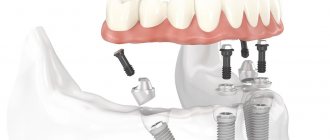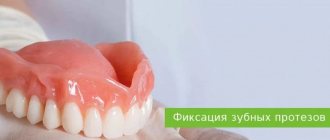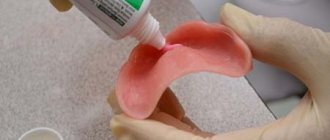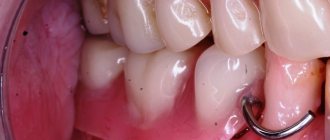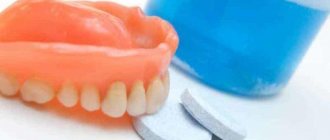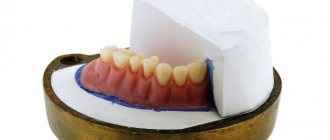When it comes to “traditional” prosthetics (without the participation of implants), the issue of installing temporary structures is often resolved “by default” (doctors sometimes say: “Don’t worry, we won’t let you go without a tooth”). Making a permanent crown may take time, and during this period aesthetic (at least) restoration is important. The doctor makes a temporary crown from a polymer material directly in his office, and this is how the aesthetic problem is solved.
When it comes to temporary prosthetics in the case of dental implantation, nuances arise. It's all about the support: the situation does not always allow for implantation with immediate loading. “Classical” implantation is also called “two-stage”:
- Stage 1 is the introduction of the implant itself and its engraftment, which takes several months.
- Stage 2 – orthopedic (the doctor installs the abutment and fixes the prosthesis).
During the first stage, the implant is unstable, so it cannot be loaded with a crown. What options are available to hide a missing tooth after implantation?
Why are temporary dentures needed?
The main purpose of a temporary prosthesis is to restore chewing function and an attractive appearance; the structures are also designed for the following purposes:
- formation of a prosthetic bed;
- preventing the displacement of healthy teeth;
- helps to reduce the period of adaptation to a permanent prosthesis;
- while wearing it, the correct bite is maintained;
- prevents inflammation and irritation of the gums;
- protects soft tissues from any damage;
- promotes uniform load distribution.
Depending on the situation, temporary removable dentures can be installed for 1-6 months. The maximum wearing period can be up to 5 years, but subject to careful use and proper oral care. Prosthetics are recommended when getting used to implants, re-prosthetics and changing teeth in children.
Call us or 8 (926) 100-10-10
How to care
Temporary restorations require the same high-quality hygienic care as regular teeth.
With poor care, the accumulation of food debris and the occurrence of unpleasant processes in the gums (swelling, pain) cannot be avoided.
Problem areas with temporary plates are the junction with the teeth and its lower part. You can combat plaque buildup in these areas by using a medium-hard toothbrush at a 45-degree angle. It is also necessary to rinse your mouth after a meal and use herbal decoctions or infusions (sage, calendula, chamomile).
You can use ready-made pharmacy rinses that contain medicinal substances and prevent gum inflammation (Forest Balsam, Lakalut, Listerine, President, etc.)
If a temporary denture is removed, it must be periodically placed in a special solution.
The solution is changed after each use. Also, special tablets for dentures are used for this (Korega, Protefix, Dentipur, etc.)
When wearing non-permanent plates, the following recommendations should be followed:
- Avoid eating sticky or very hard foods;
- minimize the chewing load on the area with the plate;
- use dental floss carefully: do not pull it out sharply, but pull it smoothly downwards away from the face.
Temporary removable dentures
The price of prosthetics is affordable, the designs are also called “butterflies”, the features include the following:
- plastic is used for manufacturing;
- easy maintenance, since the structures can be removed at any time;
- there is no need to remove dentures at night;
- fastening is performed without grinding the teeth;
- Wearing period is from 3 to 4 months.
Worth knowing! When using acrylic plastic, the patient may experience breakage of the clasps.
Prosthetics
Fixed temporary dentures for front teeth
The plastic crown is fixed with non-permanent cement; the structure can be removed at any time if necessary. Fastening can be performed on a ground tooth, which will later be used as a support for a permanent prosthesis. The entire restoration process is carried out in one visit to the dentist for 2-3 hours.
If you have any questions about the prices and timing of installing temporary dentures on your front teeth, you can always contact our specialists for advice by phone or through the feedback form.
Cost of services
If treatment is started on the day of treatment, consultation and treatment plan are free
| Cost of implantation surgery for 1 implant | 21,000 rub. |
| Cost of implants (optional implant systems: (USA, Switzerland, South Korea) | from 12,000 rub. |
| Alveolar ridge splitting (without material cost) | 12,000 rub. |
| Augmentation of the alveolar ridge in the area of 1 tooth (without material cost) | 10,000 rub. |
| The operation of placing a healing abutment | 4,000 rub. |
| Applying 1 suture (Vicryl material) | 400 RUR |
| Consultation with an implantologist based on CT scan results + treatment plan | RUB 1,000 |
What happens if you refuse to install temporary dentures?
The main purpose of a temporary prosthesis is to restore the dentition in the oral cavity until a permanent prosthesis is ready or an implant is installed.
For various reasons, this process can take a long time - from two to three weeks or more. During this period, when one or more teeth are missing, there is a high risk of complications:
- pathological change in bite;
- rapid destruction of healthy teeth due to increased load;
- a change in the position of the teeth towards a “gap” - the teeth lose not only their support point, their attachment in the sockets weakens, and all this leads to significant deformations of the dentition;
- without a prosthesis, the exposed area of the jaw will not receive the necessary load during the chewing process, which will provoke changes in the bone tissue - it will become porous, decrease in volume and will be unsuitable for prosthetics;
- The part of the mucosa not protected by the prosthesis is prone to injury when chewing.
And of course, while the prosthesis is being made, the patient should not experience psychological discomfort and be ashamed of his smile. Missing teeth, especially front teeth, is always unpleasant. Installing a temporary denture allows you to safely avoid stress and social maladjustment.
Temporary dentures are much cheaper than permanent ones, and there is no point in saving on them.
The process of addiction
Getting used to wearing temporary dentures depends on the individual’s capabilities.
For some people, this takes a few hours. However, there are also situations when the patient absolutely cannot come to terms with the presence of a foreign element in his mouth.
There should be no pain after temporary prosthetics.
Sometimes patients are concerned about changes in the amount of saliva secreted (increase or decrease). Typically, such a violation indicates poor-quality prosthetics.
To speed up the adaptation to the use of a prosthesis, doctors usually recommend using a special (intraoral) massage.
It is done like this: the index finger clamps the artificial tooth, and the thumb performs massaging movements of the gums (up and down movements, pressing, spiral movement).
Types of temporary dentures
Temporary prostheses are divided into the following types according to their area of application:
- Immediate dentures
This is one of the most affordable types of structures, with which you can restore 1-3 lost teeth in a row. They are only used when defects are enabled.
Immediate dentures are also called butterflies. The resemblance to a butterfly is given to the prosthesis by rounded clasp hooks resembling wings. With the help of these hooks, the immediate denture is securely fixed and held on healthy teeth.
The “butterfly” is a removable design that the patient can put on and take off independently. This guarantees an appropriate level of hygiene while wearing the prosthesis.
- Nylon dentures
This is a more versatile option. Nylon dentures are used for inclusionary and terminal defects, to restore an area of the jaw or in the complete absence of teeth.
Nylon dentures are also removable structures. They are fixed using suction cups or special gels and creams, which are recommended by the attending physician.
- Temporary crowns
If the tooth is not completely destroyed or looks unsightly, a crown is installed on it after grinding. And while the permanent prosthesis is being made, a temporary crown is used.
This is a permanent temporary prosthesis that solves the following problems:
- eliminates the aesthetic defect associated with the unsightly appearance of the tooth;
- protects ground teeth from adverse effects and further destruction.
The temporary crown is installed on special temporary cement so that it can be easily removed without damaging the stump.
How long can temporary crowns be worn?
Typically, temporary crowns are worn for no more than 2 months. Temporary crowns are made from plastic or composite polymers. These materials are quite porous and not very durable. Long-term wearing of temporary dental crowns is not recommended due to the strong accumulation of bacteria on the surface of the crown, which causes inflammation of the gums, as well as increased abrasion of the material.
Plastic temporary crowns can change color due to the use of coloring products - tea, coffee, red wine, etc.
Temporary crowns that will be worn for longer than 2 months are made from more durable materials.
Preparation and installation of temporary dentures
Installation of temporary prostheses helps solve aesthetic and functional problems while a permanent prosthesis or implantation is being manufactured.
But in order for the prosthesis to meet your expectations, you need to properly prepare for its installation. To do this, you will need to sanitize the oral cavity, eliminate inflammatory processes in the mucous membrane and solve all problems with diseased teeth.
If temporary dentures are recommended by your prosthodontist, do not underestimate their importance to your health and ignore the installation.
Our specialists
Okhotin Dmitry Alekseevich
General practice
Vasiliev Vasily Vyacheslavovich
Surgeon
Minaeva Ekaterina Anatolevna
Orthopedist
When are alternative methods required?
There are absolute and relative contraindications for implantation. Absolute ones are those that make implantation impossible in principle. These include:
- various pathologies of bone tissue,
- diseases of the immune system (HIV, AIDS, etc.),
- autoimmune diseases,
- oncology,
- severe infectious diseases (tuberculosis),
- nervous and mental diseases,
- blood diseases (especially bleeding disorders),
- children's age (up to 18 years).
Relative contraindications include problems that are temporary or can be corrected and, after restoration of health, allow implantation. These are states such as:
- pregnancy and lactation,
- rehabilitation period after heart attack and stroke,
- acute viral diseases,
- dental diseases (caries, pulpitis, periodontitis, stomatitis, etc.),
- exacerbation of chronic diseases,
- dysfunction of the mandibular temporal joint,
- severe atrophy of the jaw bone,
- malocclusion,
- alcoholism and drug addiction,
- poor oral hygiene.
If you are unlucky and you are one of those who are contraindicated for dental implants (at least in the next few years), then you have to look for alternative methods.
Clinic doctors
The DentaBravo clinic pays close attention to all stages of orthopedic treatment. Temporary dentures are no exception. Our specialists make aesthetic, comfortable and reliable designs for patients that will help them wait out the time of creating permanent dentures without any problems.
What is temporary prosthetics?
Temporary prosthetics are designed to hide dental defects at intermediate stages of orthopedic treatment. Such structures are made in one or two days; the material for them is usually plastic. During subsequent visits to the dentist, they are easily removed from the mouth to try on permanent dentures, and then re-attached to the teeth using special cement.
What types of temporary dentures are there?
Temporary dentures are removable and non-removable. Removable orthopedic structures are used when many or all teeth in the jaw are missing. Fixed options include temporary crowns and bridges designed to replace less significant dental defects.
When are temporary crowns used?
Temporary crowns are used to cover prepared or replace missing teeth while permanent orthopedic structures are being manufactured. In addition, they are used for implantation while artificial roots are engrafting.
What types of temporary crowns are there?
Temporary crowns can be made directly or indirectly. The first ones are created directly in the patient’s oral cavity using a tooth impression made before preparation. The latter are produced in the traditional way - in a dental laboratory. The manufacturing process of such dentures takes longer, but the crowns are stronger and more reliable, and the fit is more precise.
What is the production of temporary crowns based on Waxup?
“Waxup” is a wax composition that ideally reproduces the size and shape of future orthopedic structures, including temporary crowns. It is made in the laboratory based on previously prepared impressions of the patient’s dentition. Using this method, it is possible to create aesthetic and functional restorations taking into account the individual wishes of the patient.
What are temporary crowns needed for?
Temporary crowns allow you to: 1) restore the aesthetic appearance of the dentition; 2) normalize chewing function; 3) protect the ground teeth from chemical, temperature and other influences; 4) prevent displacement of abutment teeth; 5) prepare the gingival bed for wearing a permanent orthopedic structure, etc.
What are the disadvantages of temporary crowns?
The plastic from which temporary crowns are made in most cases has a number of disadvantages: discoloration under the influence of food coloring, insufficient strength, etc. However, as a temporary option during the production of a permanent prosthesis, this material is quite suitable.
What are temporary removable dentures?
Temporary removable dentures are orthopedic structures designed to provide aesthetics to the dentition and normalize chewing function for a certain period - from several days to several months. Removable dentures are used when many or even all teeth in a row are missing. Inexpensive materials are used for their manufacture - as a rule, it is plastic.
When are temporary removable dentures used?
Temporary removable orthopedic structures are installed for the period of production of permanent dentures in case of significant defects in the dentition. With their help, you can prevent tooth displacement.
What are the quality criteria for temporary dentures?
Temporary dentures must be aesthetic, reliable, functional and strong enough (able to withstand use for several months). An important criterion for the quality of temporary orthopedic structures is their convenience - they should not cause discomfort when worn.
What is the cost of temporary dentures?
The cost of temporary prostheses depends on the type of structure and the specific clinical picture, but, as a rule, it is low. Approximate prices for this type of service in DentaBravo dentistry can be seen in the table below, however, a detailed calculation is possible only after consultation with our specialist. To make an appointment, click on the “Submit Application” button.
